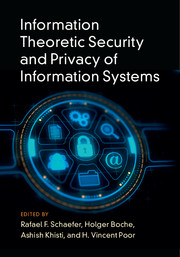Book contents
- Frontmatter
- Contents
- List of Contributors
- Preface
- Part I Theoretical Foundations
- Part II Secure Communication
- 5 Secrecy Rate Maximization in Gaussian MIMO Wiretap Channels
- 6 MIMO Wiretap Channels
- 7 MISO Wiretap Channel with Strictly Causal CSI: A Topological Viewpoint
- 8 Physical-Layer Security with Delayed, Hybrid, and Alternating Channel State Knowledge
- 9 Stochastic Orders, Alignments, and Ergodic Secrecy Capacity
- 10 The Discrete Memoryless Arbitrarily Varying Wiretap Channel
- 11 Super-Activation as a Unique Feature of Secure Communication over Arbitrarily Varying Channels
- Part III Secret Key Generation and Authentication
- Part IV Data Systems and Related Applications
- Index
- References
6 - MIMO Wiretap Channels
from Part II - Secure Communication
Published online by Cambridge University Press: 28 June 2017
- Frontmatter
- Contents
- List of Contributors
- Preface
- Part I Theoretical Foundations
- Part II Secure Communication
- 5 Secrecy Rate Maximization in Gaussian MIMO Wiretap Channels
- 6 MIMO Wiretap Channels
- 7 MISO Wiretap Channel with Strictly Causal CSI: A Topological Viewpoint
- 8 Physical-Layer Security with Delayed, Hybrid, and Alternating Channel State Knowledge
- 9 Stochastic Orders, Alignments, and Ergodic Secrecy Capacity
- 10 The Discrete Memoryless Arbitrarily Varying Wiretap Channel
- 11 Super-Activation as a Unique Feature of Secure Communication over Arbitrarily Varying Channels
- Part III Secret Key Generation and Authentication
- Part IV Data Systems and Related Applications
- Index
- References
Summary
This chapter considers securing wireless communications at the physical layer using multiple antennas. In particular, the multiple antenna (MIMO) wiretap channel is presented and its secrecy capacity is provided. Further investigation of the high-SNR characterization of the secrecy capacity, i.e., secure degrees of freedom, reveals that the secrecy capacity of the MIMO wiretap channel does not scale with the transmit power when the eavesdropper has an advantage over the legitimate transmitter in the number of antennas. An external multi-antenna cooperative jammer terminal is introduced to the channel model in order to improve its secrecy capacity scaling with power. The secure degrees of freedom for this new multi-terminal multi-antenna channel is characterized. While for these models the eavesdropper channel state information is known at the legitimate terminals, the chapter next removes this assumption and presents results that utilize multiple antennas in order to provide secure communications irrespective of the eavesdropper channel state. An achievable strong secrecy rate and the secure degrees of freedom characterization for the MIMO wiretap channel when the eavesdropper channel is arbitrary, varying, and unknown at the legitimate terminals are presented. Finally, the extension of this model to the two-user multiple access MIMO wiretap channel is considered and its secure degrees of freedom region is characterized.
Introduction
The wiretap channel and the notion of secrecy capacity, introduced in [1] and generalized by [2], have provided the framework for physical layer design for wireless channels with information theoretic guarantees against eavesdropping. A natural model in wireless communications is one which utilizes multiple antennas for transmission and reception at each node. The improvement in secrecy rate that can be obtained using multiple antennas in a point-to-point channel with an eavesdropper has been studied extensively in several references, including [3, 4]. Specifically, the secrecy capacity of the Gaussian model consisting of a multiple antenna legitimate transmitter, a multiple antenna legitimate receiver, and a multiple antenna eavesdropper, termed the multiple-input multiple-output (MIMO) wiretap channel, has been identified in full generality in [5, 6].
- Type
- Chapter
- Information
- Publisher: Cambridge University PressPrint publication year: 2017



